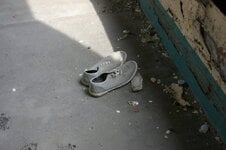This part demolished grade II listed mill in the heart of Bradford was originally built in 1871 and was home to British Mohair Suppliers (Mohair is a type of wool made from the hair of a goat) – it closed around 2001 and has since been part demolished to make way for a £35 million pound mixed residential/commercial complex.
While West Yorkshire's woollen mills were booming in Victorian times, life was not so fun for many of the workers they employed. It was typical in 1849 to work a 12-hour day and 60-hour week, with an hour and half for meals - which remained the case until 1870.
Workers in the local mills were predominantly young and female, with a dozen women, boys and girls for every man. Many of the children employed were 'half-timers' who worked at the mill for half a day and spent the other half at school.
Onlookers - men paid to work with women - earned up to 22 shillings a week, while women working in the weaving shed received up to 10 shillings.
One washroom had to serve 34 workers in a single mill, and children employed there were often susceptible to illness. The life expectancy for tradesman was just 25 years - compared to 60 for the upper classes.
Wool was a dominant industry in northern England until retailers began to look abroad for lower production costs in the 20th century.
150 years ago these now-derelict woollen mills would have been noisy, stifling and full of toiling workers on 60-hour weeks. But gone are the days when the huge mills towered above the skyline of Bradford, helping to make the county the wool capital of the world. Now, almost a century after the area’s wool makers pulled their final threads, the eerie shells of its forgotten mills are being brought back to life, demolished or left to fall into ruin.
The Crew and I, along with the Urbex Hound visited recently and had a good mooch around, some areas of the site are needle heavy, some areas derelict , some awaiting the long promised revamp into luxury apartments.
A bit photo heavy so I'll probably do a Part 2 to this.
















Bradford's budding Artists









This was like a scene out of Reservoir Dogs, dark basement came around a corner and torchlight fell on this.




While West Yorkshire's woollen mills were booming in Victorian times, life was not so fun for many of the workers they employed. It was typical in 1849 to work a 12-hour day and 60-hour week, with an hour and half for meals - which remained the case until 1870.
Workers in the local mills were predominantly young and female, with a dozen women, boys and girls for every man. Many of the children employed were 'half-timers' who worked at the mill for half a day and spent the other half at school.
Onlookers - men paid to work with women - earned up to 22 shillings a week, while women working in the weaving shed received up to 10 shillings.
One washroom had to serve 34 workers in a single mill, and children employed there were often susceptible to illness. The life expectancy for tradesman was just 25 years - compared to 60 for the upper classes.
Wool was a dominant industry in northern England until retailers began to look abroad for lower production costs in the 20th century.
150 years ago these now-derelict woollen mills would have been noisy, stifling and full of toiling workers on 60-hour weeks. But gone are the days when the huge mills towered above the skyline of Bradford, helping to make the county the wool capital of the world. Now, almost a century after the area’s wool makers pulled their final threads, the eerie shells of its forgotten mills are being brought back to life, demolished or left to fall into ruin.
The Crew and I, along with the Urbex Hound visited recently and had a good mooch around, some areas of the site are needle heavy, some areas derelict , some awaiting the long promised revamp into luxury apartments.
A bit photo heavy so I'll probably do a Part 2 to this.
Bradford's budding Artists
This was like a scene out of Reservoir Dogs, dark basement came around a corner and torchlight fell on this.
Attachments
Last edited:



